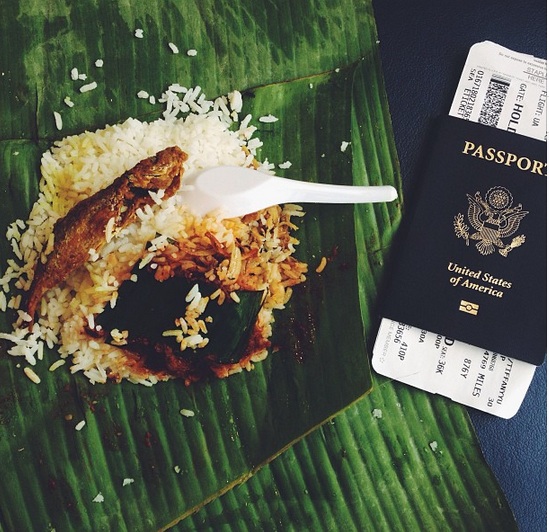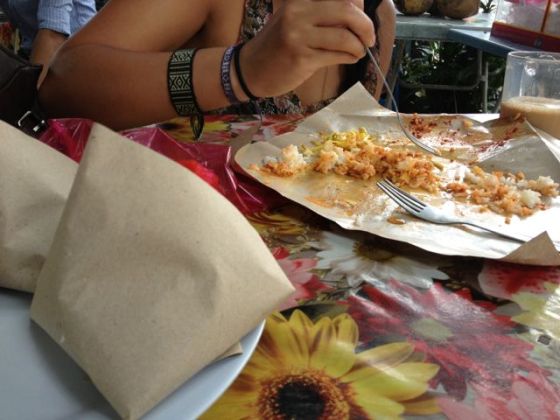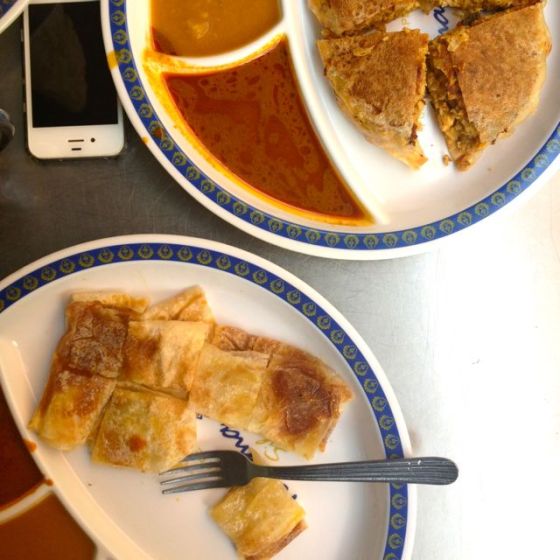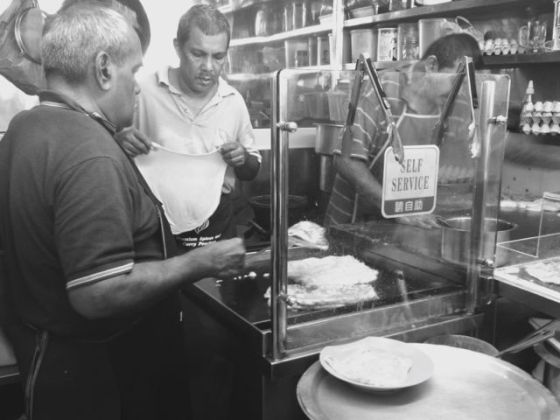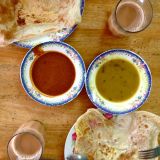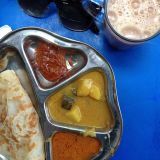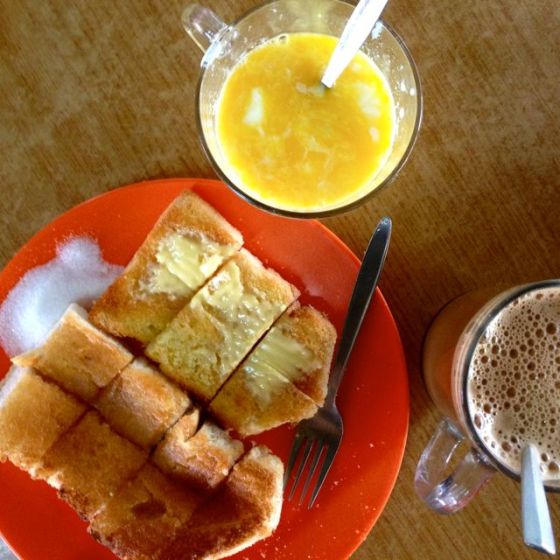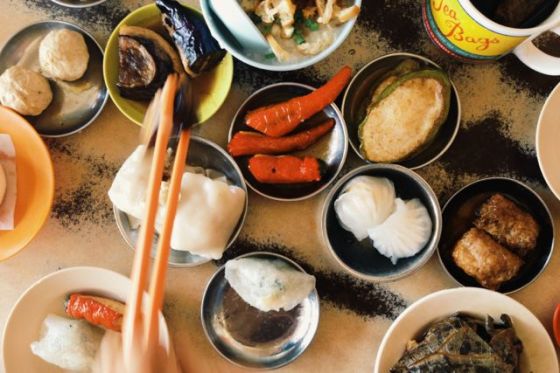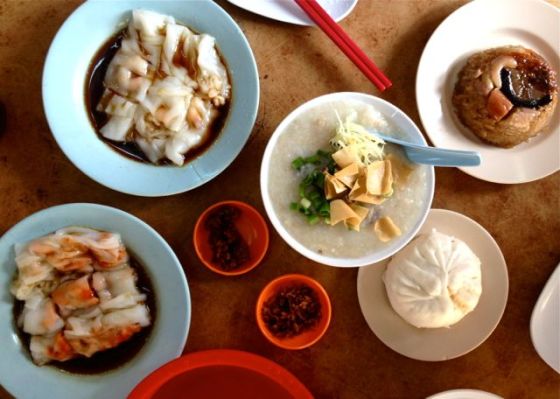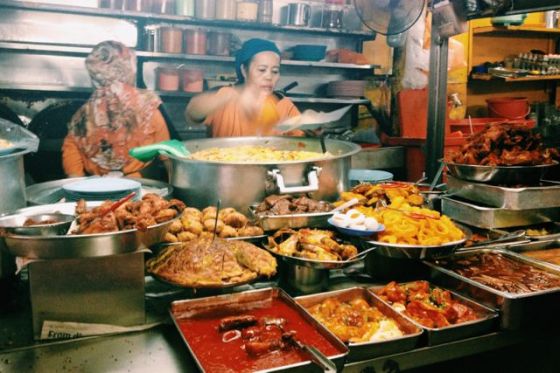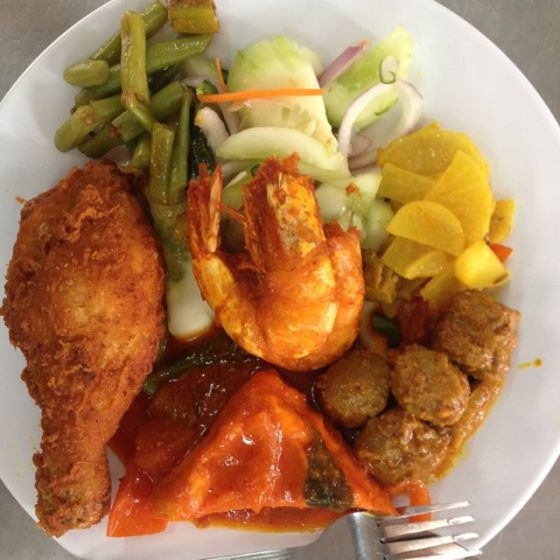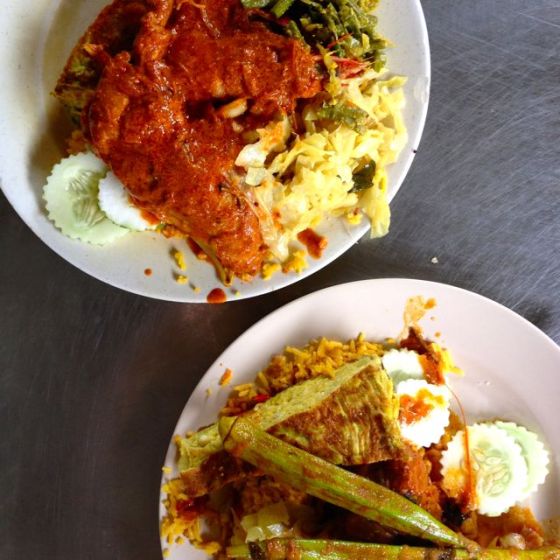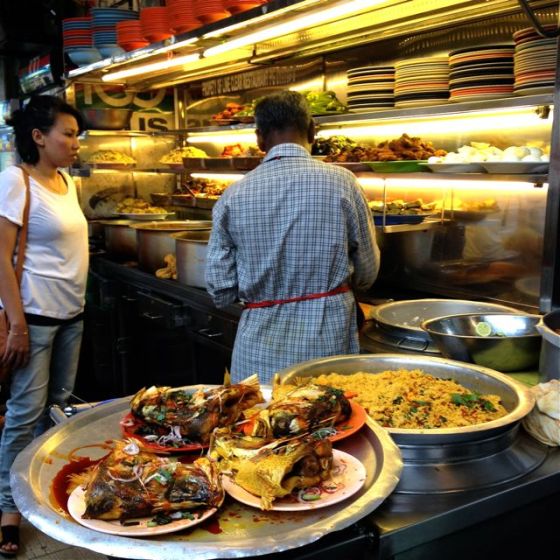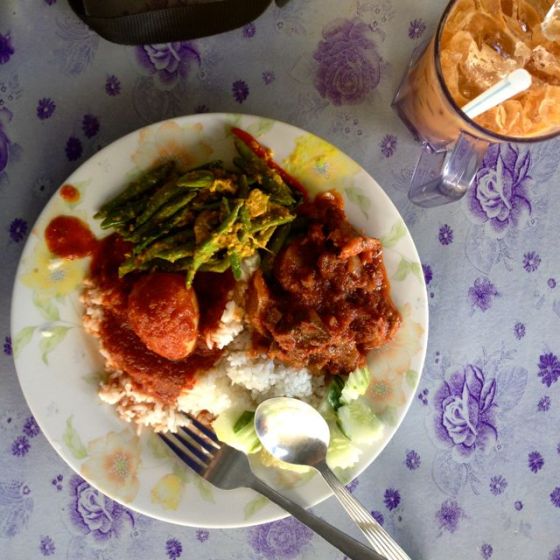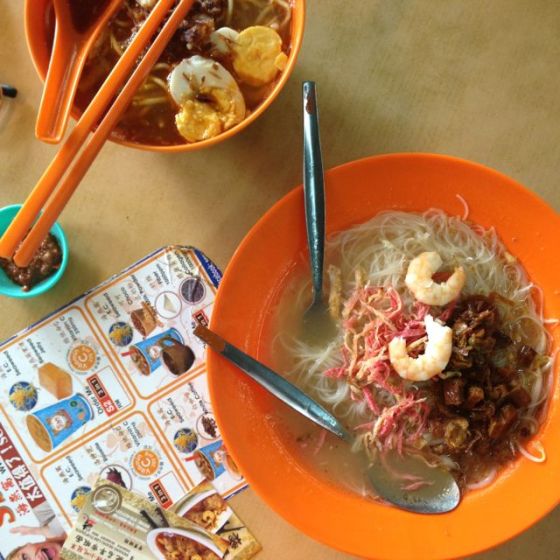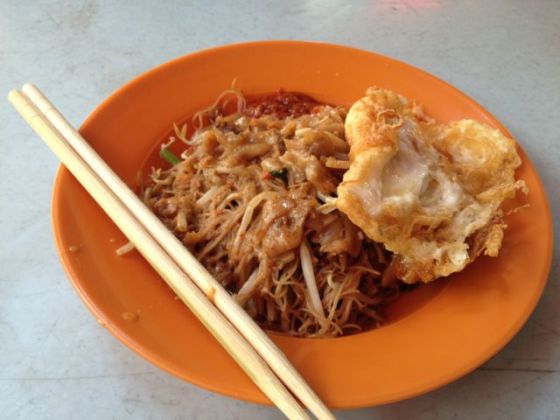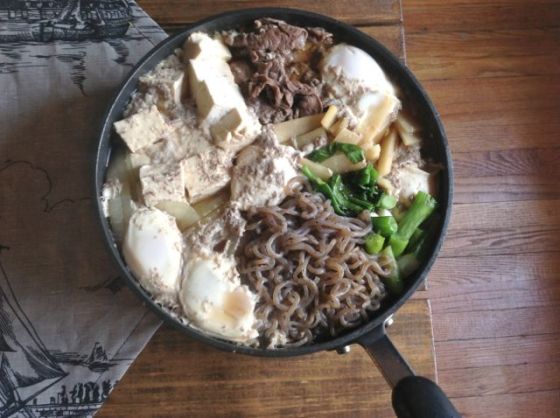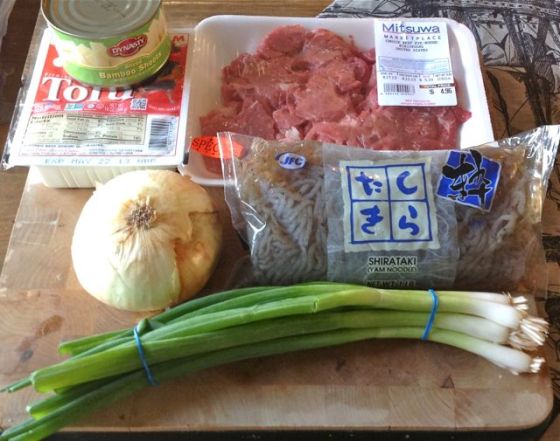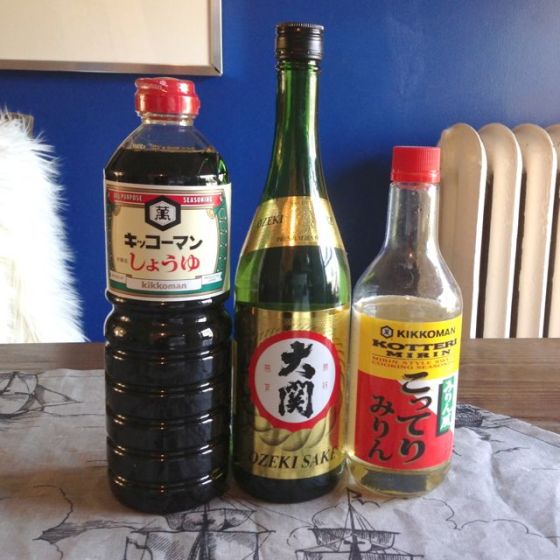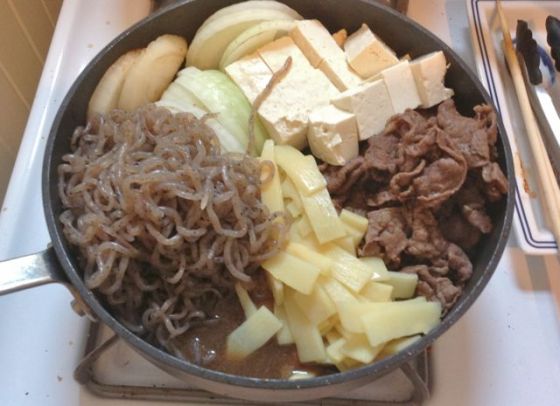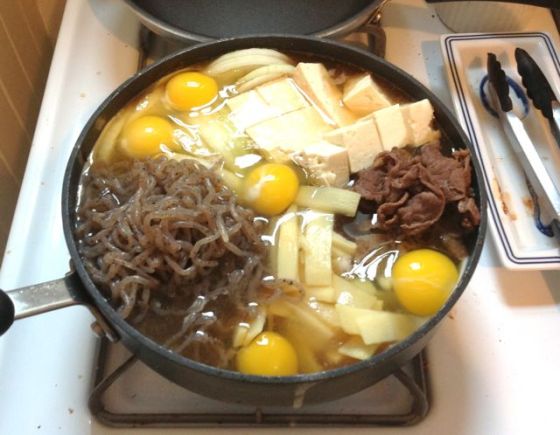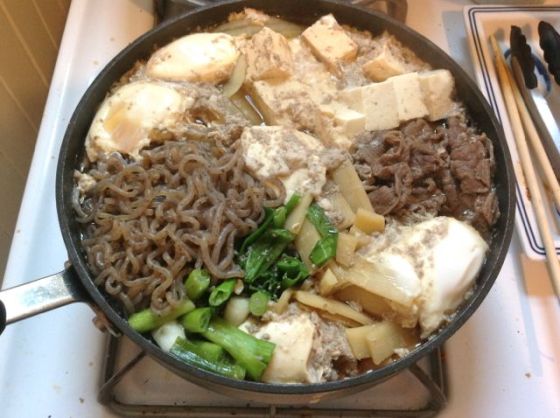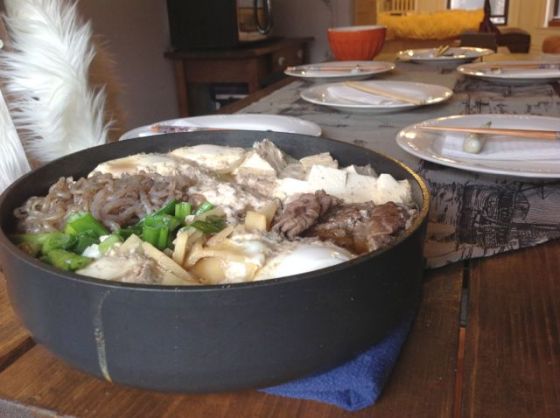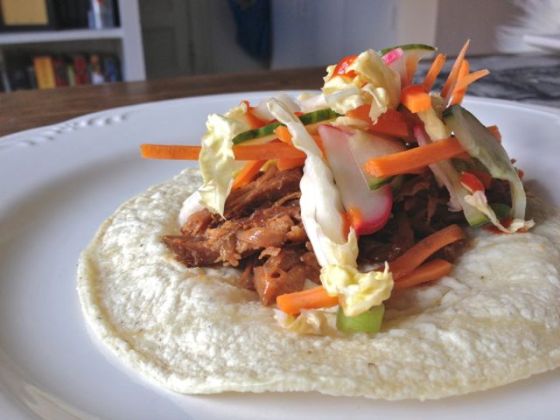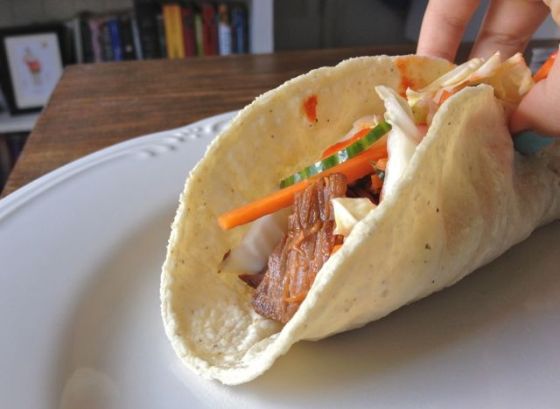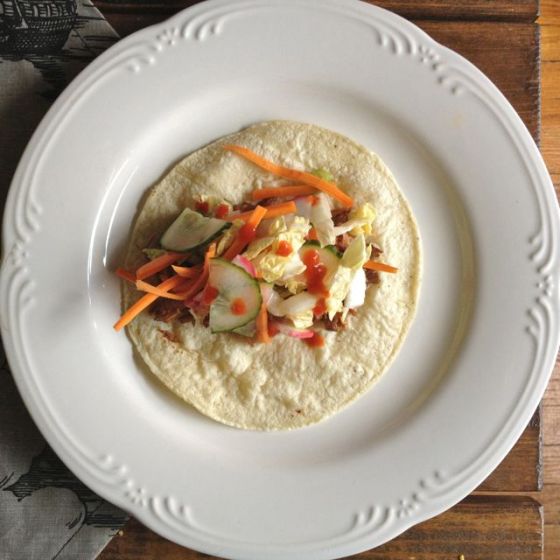Miss Fats apologizes for neglecting you all. It’s been a crazy month back in the U.S. that has mostly consisted of overwhelming work nonsense and persistent cravings for Malaysian cuisine followed by acute stints of post-travel depression. She is not happy that her life is no longer organized around which dirty alleyway or food cart contains her next meal. #firstworldproblems
But Miss Fats’ spirits have been successfully raised in the last week. After the slow accumulation of ingredients, she managed to recreate one of her favorite Malaysian dishes: Nasi Lemak. This weird little bundle of joy is a very traditional morning meal. Though it varies across the country, Nasi Lemak is typically coconut rice topped with spicy sambal, ikan bilis (fried anchovies), peanuts, an egg, and chopped cucumber, all wrapped up in a banana leaf or butcher paper for your on-the-go convenience. This breakfast prism can be found at most nasi kandar (Mamak buffet-style) stands, Malaysian food cars/trucks/bikes, or hawker centers. Miss Fats became obsessed with the spicy sambal “crack sauce” that seeped into that coconut rice, hiding the crunchy bites of peanuts just waiting to be unearthed from beneath the fried fish bites and crispy cucumbers. She cannot convey just how amazing a perfect bite of nasi lemak can be: you get a little egg, little saucy rice, little fish, and a peanut all in your spoon and you’re in crazy mouth explosion territory. The best part of this bundle? Going rate was around 1.50 ringgit (that’s less than 50 cents US). Needless to say, the Malaysians have breakfast figured out.
Miss Fats has been dying to recreate the experience since returning to the US, and finally, last week, she was able to collect all the necessary ingredients (and substitutions) to make it happen. It wasn’t the same—no banana leaf, no crispy whole mini fish bites—but the flavors of that sauce were close enough to briefly transport her back to the sticky plastic tables of a Malaysian roadside stand. So in celebration of her relatively successful virtual food-cation, Miss Fats will be running down some of her favorite breakfasts she had abroad, and share her America-friendly recipe with you all. She hopes by the end you are all converts to the proper way of eating: excessive meat and bread breakfasts for all.
Roti Canai or Pratha
This might be the breakfast. Or at least wins Miss Fat and T’s “most consumed” contest. T was essentially obsessed with this bready breakfast from the first time she laid eyes on it in Singapore. Walking by the local banana leaf shop, she eyed the crispy naan-looking flat bread on everyone’s plate. She immediately declared that they would have to stop tomorrow morning to investigate. The next day, after the usual ordering protocol of pointing and asking for “whatever they are having,” they discovered the simple magic of pratha (or roti canai in Malaysia). This chewy and crispy flat bread may look similar to naan, but is incredibly different. After some research, Miss Fats discovered it’s made with standard wheat flour and ghee (no leveners here).
Unlike naan’s place in a tandoori pot, roti canai is made on a scorching hot flat top where it undergoes a process of stretching and folding, giving its crispy, slightly puffed chewy texture. She wishes she could count the number of time she just stared at the cooks effortlessly pulling the little balls of dough into paper-think sheets and throwing them down on the stove. Using two flat spatulas, they’d fold and pull, fold and pull, eventually fluffing the bready pocket, only to beat it down at the last minute, allowing for one last crispy layer to develop on the bottom. Roti canai are typically served up with two spicy bowls of curry business: one is usually a yellow milder daal, alongside a deep red spicy sauce. Unlike many other Indian-influenced Malaysian dishes, you actually consume this with a fork and spoon. Tearing the bread apart, you dunk those bites into both sauces and shovel away into your mouth. Not to mention you can get these buttery pockets stuffed with a whole range of items, the most common being: egg, onion, butter, sardines, cheese (like American cheese, y’all), and banana. Miss Fats tended to favor the standard roti canai, served up with a milky teh tarik (pulled tea with sweetened condensed milk), but she was a HUGE fan of the roti kaya variation. This option featured the roti stuffed with a healthy scoop of kaya (coconut egg jam) and was still served up with the two standard dips. The sweet coconut jam, bread and spicy curry all melded into the most insane sweet, savory mouth time ever.
Perhaps the strangest, but most exciting variation was the roti tisu. This was T’s favorite sweet version of the classic, featuring paper-thin bread, stretched and molded into a towering cone. The whole thing is then drizzled in honey and you’re left to go at with your fingers, cracking off pieces of flaky, honey-soaked bread. Unfortunately the tisu doesn’t typically come with those spicy dips, but T was always snagging some of Miss Fats to ensure optimal sweet/spicy/savory flavor action.
Kaya Toast
Since Miss Fats has already introduced you to kaya, she thought she should talk a little more about a favorite breakfast that essentially revolves around the magic egg jam. From the limited research Miss Fats has executed, she believes kaya toast comes from Hong Kong. However it seems to be a favorite in Malaysia, particularly in areas populated by Chinese immigrants. This simple breakfast features a thick piece of perfectly toasted egg-y Asian bread (no crusts!) topped with a healthy spread of kaya jam and margarine. The toast is served up alongside two soft-boiled eggs and spoon full of sugar. After watching many old men eat this dish, Miss Fats and T discovered that you’re supposed to drizzle a little soy sauce into those eggs and mix them up real good. Then you dip your toast in sugar and then the eggs, sopping up all that yolky goodness, and again, diving right into the sweet savory breakfast party.
It wasn’t until Miss Fats arrived in Penang that she had the chance to try this dish out, and boy was she pissed that she’d wasted so much time without kaya toast in her life. Determined to try this dish, she researched the best toast in Georgetown (not an easy task: Google hates Malaysia). She settled on a little café where an old woman spends four hours slowing cooking the jam and even sells jars of it for all the kaya addicts out there. Naturally Miss Fats bought a ton and proceeded to carry these strange little jars of coconut jam around with her for the next two weeks, dipping any cracker-like object into the sticky sweet tub permanently sitting on her bedside table. Why kaya doesn’t exist in the US is beyond Miss Fats; and unfortunately her hoarded supply is dwindling. She is seriously going to have to work on her egg jam skills, because Miss Fats is fairly certain she will die without it.
Dim Sum
Alright, this is hardly new. However Malaysia has a huge Chinese immigrant population, so dim sum breakfast is a standard throughout the country. Miss Fats and T ‘summed it up a couple of times: indulging in as many pork and leek dumplings, sticky rice and bowls of congee as possible. She’ll save you the detailed descriptions of each and every little dish, and instead allow the beautiful pictures to do the talking. Some of Miss Fats’ favorites included the fishcake stuffed Japanese eggplant and peppers, BBQ pork stuffed folded rice sheets, and steamed shrimp dumplings. Miss Fats and I would load up their table with as many little bowls as possible and pop little dumpling bite after bite. It’s hard to say how different Malaysian dim sum is from giant restaurants stuffed with people every Sunday in the US: Miss Fats is no dim sum expert. However she will say that she had some of the best BBQ pork of her life, stuffed in a perfectly steamed hum bow in Penang. Whatever they’re doing to the pork in that city: keep it up.
Nasi Kandar
Nasi kandar has come up a couple of times now, and is hardly specific to breakfast. In fact, it’s really more of a twenty-four hour buffet of Mamak delights. However, Miss Fats and T frequently began their day at the kandar (and they were hardly the only ones at it). The basic premise is a you’re given a heaping plate of rice that you top with as many scoops of Malaysian curry, vegetables or meats as you’d like.
Now it took a long time for Miss Fats and T to figure this shit out. And she’s not even entirely sure how it works now. Typically, you’ve got a wide spread of dishes including various meat curries, stewed vegetables and big trays of crispy friend chicken. You’re then welcome to scoop (or sometimes there’s someone there to serve them up for you) as many of them as you’d like. Now it’s the payment part that always confused them. You are typically charged per scoop, or per hunk of meat; vegetables cost less and the chicken is most expensive. Now this is a problem if you’re like Miss Fats and T who like to sample absolutely everything. Coming off their experience at the Indian buffet—where they’d perfected the tiny sample scoop technique to ensure optimal testing—this made for some expensive trips to kandar in the beginning (see above: not how you kandar). They would often get very confused looks as to why they would waste a scoop on such small portion of curry.
Kandar is incredibly affordable if you work it like a local, and by the end, Miss Fats getting the hang of things. Essentially you should pick one meat curry—Miss Fats’ favorite was typically mutton—and go for one big hunk. With the meat curries you’re allowed additional scoops of all the saucy goodness it’s sitting in, so go ahead and dip back in for some of that meaty curry business. Then you follow with a good scoop or two of vegetables—typically some sort of cabbage, or if you’re lucky, okra. Then just throw down an egg for good measure. Top that all off with some of the free crushed peanuts and cucumber slices sitting at the end. Boom: the most hearty meat breakfast of your life. Good fucking morning.
Now, what Miss Fats and T could never figure out was the extra sauce scoop action she frequently saw locals indulging in. Apparently one can ask for just a scoop of a meat sauce to top off their meal mound, but whether there was a charge and how much that would be, is beyond Miss Fats. She eventually succumbed to just being careful about the number of meat pieces and just paid whatever price she was told at the register. Who knows: maybe she doesn’t understand kandar at all. Other than it’s worth any cost because frankly, a good day should begin with a hunk of mutton on bed of fragrant rice. Topped with an egg. Obviously.
All the rest:
It’s difficult to say whether some of the dishes they had were standard breakfast fair, however Miss Fats and T found that most cities served up all meals, all day (and all night). Therefore they were often indulging in giant steaming bowls of noodle-y soup first thing in the morning. Or consuming piles of “dry” wonton noodles and dumplings with a smattering of duck sauce over top. They operated under the premise that breakfast was important primer step for their day of eating ahead. Therefore copious amounts of meats and carbs were meant to both fuel and stretch their bloated bodies and allow for optimal consumption and energy throughout the day.
So in the spirit of beginning your day with a meaty gut-brick meant to power endless consumption and mindless wandering, Miss Fats would like to share her recipe for nasi lemak with all of you. The traditional dish has been significantly altered due to missing ingredients stateside (not to mention Miss Fats land-locked geographic location), but she found this recipe to produce satisfying flavors of Malaysia that brought her right back to those banana leaf prism bundles of joy. She hopes you all will give this a try so you can get a little taste of just how goddamn amazing Malaysian flavors can truly be. For realz: it’s unlike anything you’ve ever tasted.
Nasi Lemak
makes 4 servings
adapted from Rasa Malaysia
2 cups basmati rice
1 can coconut milk
good pinch of salt
4 shallots
1 clove garlic
15 dried chili peppers*
1 tsp jeotgal (Korean salted, fermented shrimp) **
1 small can of anchovies in oil
1 half red onion, sliced into thin half rings
1 cup tamarind juice***
1 tbs sugar
salt to taste
water
1 can sardines in water, drained
4 hard boiled or fried eggs
chopped cucumber
crushed, toasted peanuts
*Miss Fats still has no idea what kind of chilies she was supposed to use. She went with the dried serano peppers that you can find in big bins in the produce section of the grocery store. Who know if she was right. She recommends going for whatever is the most red, or the largest if you’re afraid of it being too spicy.
**She substituted the Korean fermented shrimp because there was no damn way she was going to be able to get her hands on Malaysian belacan (traditional salted shrimp paste). She’s pretty sure you can also use a Chinese version of shrimp paste. Both should be available in most Asian grocery store and lasts in the fridge for basically forever.
***Supposedly you can soak that boxed tamarind you find in some produce sections and Indian grocery stores. Miss Fats has no idea how to do this. She instead dissolved about 1 tsp of tamarind paste in water. She found the tamarind paste at Whole Foods (vastly overpriced) and eventually was able to pick up some tamarind concentrate at an Indian grocery store.
1. Cook the rice as you typically would, simply substituting the water with coconut milk.
2. In a food processor, combine the shallots, garlic, chilies and shrimp. Blend until you get a relatively-smooth paste.
3. Heat a saucepan and cook the paste until fragrant. Stir in the anchovies, red onion, sugar and tamarind juice. Reduce heat to medium low and simmer until the onion rings become soft and nearly disinegrate into the sauce and you get a thick, dark red gravy. Salt and sugar to taste.
4. To serve, lay down a bed of rice, top with a healthy scooping of the sauce. Top with the fish and garnish with a small pile of cucumbers and a sprinkling of peanuts. Finish it off with the egg.
Miss Fats highly recommends just mixing all that rice and sauce together and then trying to get spoonfulls that perfectly balance the soaked rice with a crispy cucumber and bite of peanut. She can’t even describe how good that perfect marriage of egg, sauce, peanut, fish can be. Just eat it now, because there’s no possible way your brain can try to imagine this flavor/texture combination. It’s something you have to try for yourself and allow your imagination to implode as your entire flavor palate becomes refigured through the flavors of Malaysian cooking.
